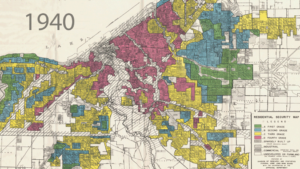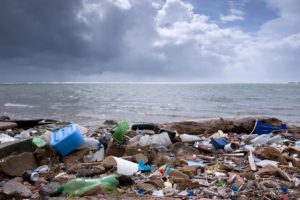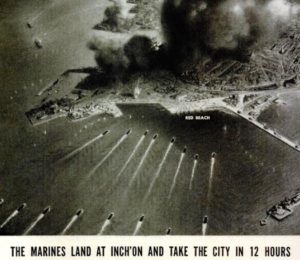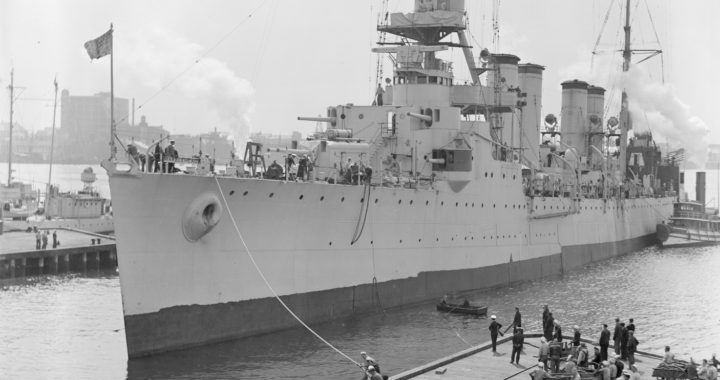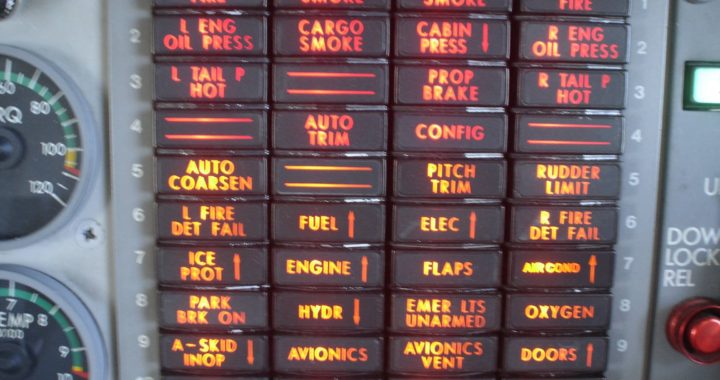Three Japanese bombs saved the USS Marblehead from total destruction in February 1942.
Nearly sunk by Japanese land-based bombers at the battle of Makassar Strait on 4 February 1942, the American light cruiser Marblehead was kept afloat by heroic damage control, inspiring leadership, rigorous training, and the unrelenting courage of her crew. Though grievously damaged – a nine-foot hole in her hull, thirty-four compartments flooded, steering inoperable, electical power reduced, speed nearly halved – during the next 89 days Marblehead sailed more than 20,000 miles to the U.S. east coast for repairs that allowed her to return to the fight before the end of 1942.
Had Japanese pilots missed their target and had Marblehead remained in the combat theater, she almost certainly would have shared the fate of the American cruiser Houston, the Dutch cruisers De Ruyter and Java, the British cruiser Exeter, and the Australian cruiser Perth, all of which were sunk in the doomed allied attempt to defend the the Netherlands East Indies from Japanese invaders during the first three months of 1942.
But Marblehead survived, and her crew of more than 450 men avoided death or years of brutal captivity as prisoners of war.
USS Marblehead was an Omaha-class light cruiser, designed during the First World War and commissioned in 1923. Intended to serve as a long-range scout for the main force of battleships and heavy cruisers, Marblehead and her sisters were optimized for speed and endurance. They originally carried twelve 6-inch guns, mounted in a pair of two-gun turrets and eight casement mounts, an arrangement more appropriate to the Spanish-American War than to World War II.
By the late 1930’s the Omaha cruisers were thoroughly obsolete, though Marblehead herself could still approach her designed speed of 34 knots.
Marblehead had been assigned to the U. S. Asiatic Fleet in 1938, as China’s peasant armies struggled to stem the Japanese invasion of their country. For the next three years Marblehead and the rest of the Asiatic Fleet could only watch nervously as diplomatic relations between America and Japan deteriorated and the Imperial Japanese Navy strengthened its fleet with modern ships and aircraft, gained combat experience, and perfected the world’s most potent aircraft carrier strike force.
Throughout this period the Asiatic Fleet remained woefully weak, with just a pair of cruisers – Marblehead and Houston – twelve aging destroyers, fifteen submarines, and a motley collection of obsolete river craft, escort vessels, minesweepers, tenders, and patrol planes.
But even as war with Japan drew ever-more certain, the U. S. Navy could not spare additional vessels to shore up the Asiatic Fleet. U. S. war plans called for the Asiatic Fleet to fight a rear-guard delaying action, supporting American ground forces in the Philippines as long as possible, then retreating south to support the defense of Singapore and the Dutch East Indies. If those efforts failed, the Asiatic Fleet would retreat further to Australia.
But when war came, the power and speed of the Japanese advance shocked American and allied planners. Eight U. S. battleships were sunk or damaged at Pearl Harbor on 7 December 1941, and British naval power in Asia was broken with the loss of HMS Repulse and HMS Prince of Wales to Japanese air attacks on 8 December. U. S. airpower in the Philippines was virtually destroyed the same day, and the American naval base at Cavite in Manila Bay was wrecked by Japanese air attacks on 10 December. Before the war was four days old, any hope for an effective naval defense of the Philippines was lost.
Within weeks the Asiatic Fleet became part of the hastily organized American, British, Dutch, and Australia (ABDA) command. Unsurprisingly, ABDA’s aging ships and untrained crews would prove to be no match for the disciplined, superbly trained, and well-equipped Japanese.
If ABDA had been created a year or two sooner, if its units had ever worked together and established communications and operational protocols, if the nations involved had agreed on a common strategy, and if the various senior leaders had put aside personal animosities, perhaps ABDA could have put up a stouter defense.
As it was though, the brief, inglorious history of ABDA was a sad tale of neglect, hubris, and hopeless courage in the face of overwhelming Japanese power, leaving the crews of individual ships – including Marblehead – to pay the price.
The end would come quickly for ABDA, but not without a fight. On 24 January 1942, four U. S. destroyers attacked a Japanese landing force at Balikpapan, sinking four transports and a patrol boat.
Marblehead had originally been assigned to participate in the attack, but engine problems forced her out of the line-up. She was replaced by USS Boise, a recent addition to the ABDA fleet. But on the day before the attack, Boise struck an uncharted coral head in the Sapi Strait, damaging her hull and forcing her to withdraw to Ceylon for repairs. She, too, survived the coming disaster. Marblehead was quickly assigned in her stead, but was not able to reach Balikpapan in time to join the attack.
A second attack against Japanese transport shipping planned for 31 January was cancelled when a U. S. scout plane discovered that the Japanese force at Balikpapan had been reinforced by additional cruisers and destroyers. So, the allies assembled a larger force of four cruisers – including Marblehead – and seven destroyers and headed for Makassar Strait.
They never got there.
Japanese aircraft spotted the allied ships near Cape Maduro in the Java Sea and at 9:50 am on 4 February 1942, 36 Japanese bombers attacked the ABDA ships. No allied ships were sunk, but USS Houston suffered a hit that killed 48 sailors and disabled her aft eight-inch gun turret and Marblehead was nearly destroyed.
For more than thirty minutes Marblehead dodged Japanese bombs, twisting and turning at full speed, and throwing up as much anti-aircraft fire as her furious gunners could manage. But at 10:26 am, eight single-engine Japanese bombers passed directly overhead, dropping eight bombs that straddled the ship. One bomb struck Marblehead’s stern, another struck amidships, and a third exploded close aboard forward. Large fires erupted amidships and at the stern and the ship quickly listed eight degrees to starboard. Unseen from the bridge, the near miss off the port bow had ruptured the cruiser’s hull and tons of seawater were rushing into the ship.
Below decks the cruiser was a flaming wreck. The bombs had destroyed the wardroom, which was being used as an emergency medical station, the sick bay below, and the emergency steering room, jamming the ship’s rudders at hard left. Engines racing, Marblehead could only circle to port as gunners peered skyward to spot any further attacks. The main deck was ripped open at the stern; power, water, and communications lines were cut; most berthing areas were smashed; and the after turret was inoperable.
Damage control parties rushed to extinguish fires, shore up damaged compartments, and take stock of the ship’s condition. Twelve crewmen were dead and more than 70 were wounded, some mortally. By noon – less than two hours after the bomb strikes – the fires were out and the rudder had been nearly centered at nine degrees left, although it was still immobile.
But the engines were working and if she held together and stayed afloat Marblehead could still make better than twenty knots. She could be steered on a general course by adjusting the speed of the engines, although she was continually swinging 40 to 50 degrees off course. Twenty-six compartments were flooded completely and eight others were partially flooded. Although the list had been corrected, Marblehead was down by the head by ten feet, and was continuing to flood. She was, in fact, sinking. Already the bow was barely above the sea.
With no reserve buoyancy, all that was keeping her afloat was the creaking efforts of the overworked pumps and desperate bailing by the crew. Any further battle damage would almost certainly sink the ship, and Marblehead was unlikely to survive even moderately heavy seas. In addition, many of the wounded needed treatment that the damaged ship could not provide – they would die if they could not get to a hospital soon. The nearest port with a hospital and rudimentary repair facilities was Tjilitjap, more than 400 miles away. Getting there would require taking the unsteerable, sinking ship through narrow Lombok Strait, with its rushing four-knot current and uncharted shoals. Marblehead would be escorted by two destroyers, but she would remain within range of Japanese bombers the entire way and would be crossing waters that were likely to harbor Japanese submarines.
Her first moments in the strait were hardly promising. As soon as Marblehead entered the rushing current she was pushed fifty degrees off course. Rather than try to recover, Marblehead’s commanding officer, Captain Arthur Robinson, let the ship complete a full circle before trying again. Marblehead made it into the strait on the second try, and somehow stayed off the rocks, even as rain squalls reduced visibility to zero.
They cleared the strait just after midnight and headed west for Tjilatjap. During the long night the crew struggled to keep their ravaged ship afloat. They gained an edge when they manhandled a 3.5-ton pump from the engine room to the main deck where it could match the water rushing in through the breached hull.
That afternoon another flight of Japanese bombers sighted Marblehead and her escorts. But the Japanese planes focused their attacks on the destroyer Paul Jones, possibly mistaking her for the cruiser, and no planes made runs at Marblehead. Undamaged and fully maneuverable, Paul Jones escaped unscathed. Finally, at dawn on February 6, nearly two days after the battle, Marblehead reached Tjilatjap.
But Marblehead’s troubles were far from over. Although there was a Dutch hospital that could care for the most seriously wounded, and a cemetery for the dead, the only drydock in the small port was a floating dock that was too short to accommodate the 550-foot-long cruiser. Unless they could get the ship’s damaged bow out of the water, they had no hope of patching the hole in her bottom.
So they did.
The drydock crew flooded the dock, sinking it below the keel of Marblehead. They then hauled the cruiser’s bow across the threshold, secured the ship as best they could, and pumped out the dock’s tanks, raising the dock and lifting the forward half of Marblehead. The cruiser slanted alarmingly, but the stern remained afloat and the damaged bow was clear of the water. This was no one’s idea of a proper docking and Marblehead was as likely to slide sternward off the dock or capsize the whole rig as it was to remain upright.
But there were no other options and somehow Marblehead stayed put. The docking took three tries, but the third was successful and workers were able to patch the nine-foot hole the near-miss had opened in the ship’s hull. With the massive main engines located near the stern, it was too risky even for Marblehead’s dauntless engineers to try to raise the stern, so repairs to the steering gear would have to wait.
The rudder was still inoperable and not all the leaks could be fixed, but Marblehead’s crew could continue to steer by engines and the ship’s pumps might conceivably keep the vessel afloat during the long voyage to the nearest allied shipyard. Most guns were operable, a temporary patch had been placed over the damaged deck at the stern, additional liferafts had been installed, tons of debris were removed from the ship’s interior, and a device was constructed that would measure the flexing of the damaged hull to give the crew some warning if the ship were about to break apart. It was time to go.
On 13 February 1942, after six days in Tjilatjap under constant threat of Japanese air attack, Marblehead got underway for Ceylon, nearly 4,000 miles distant. Left behind were more than 30 badly wounded sailors who remained at the Dutch hospital and fourteen Marblehead crewmen who had been buried in the European Cemetery at Tjilatjap.
The cruiser hadn’t gone a mile when fresh disaster nearly struck. Unable to steer a straight course, Marblehead was being towed through the minefield protecting Tjilatjap when the towline parted, leaving the damaged cruiser adrift in the narrow channel, surrounded by mines. As the tug backed toward the cruiser to remake the tow, she struck Marblehead’s stem hard, bending the cruiser’s bow and opening a hole near the waterline in the only forward compartment that was still watertight. Miraculously, the Dutch pilot was able to steer Marblehead out of the minefield using the engines.
One more leak wasn’t going to make much difference, so the barely seaworthy and only marginally steerable Marblehead headed for Ceylon, escorted by the submarine tender USS Otus. The tender provided little combat capability, but she wasn’t there to fight; her task was to pick up any survivors if Marblehead went down during the transit, an eventuality which seemed entirely possible, if not exactly likely.
During the voyage, Marblehead’s crew continued to make repairs. Electricians restored electrical power to more parts of the ship while engineers restored fresh water to much of the vessel. They even constructed a make-shift ice machine. These repairs helped, but the ship still needed extensive repairs and drydocking.
But upon arriving at Ceylon on 21 February, Marblehead’s crew was dismayed to learn – though they could hardly have been surprised – that the dockyard was booked for the next month and major repairs would have to wait. So they continued to work on their ship themselves, and by 2 March they managed to repair the steering motors by using parts salvaged from other equipment that had been damaged in the battle. The rudder wouldn’t have full range of motion, and it would have to be operated from the steering engine room, but it was vastly better than steering by engines.
Within an hour of the successful test of the steering gear Marblehead was underway. On 15 March they reached South Africa, where they refueled before entering the Royal Navy dockyard at Simonstown on 24 March.
On 15 April, the freshly patched, fully steerable, and agreeably habitable Marblehead left Simonstown for the final leg of her voyage home. Around the Cape of Good Hope, to Recife, Brazil, and finally, on 4 May 1942, to the Brooklyn Navy Yard in New York Harbor, where permanent repairs and modernizing updates were completed. On 14 October 1942 Marblehead rejoined the U. S. fleet. She served until the end of the war, oulasting virtually the entire Imperial Japanese Navy.
Marblehead’s journey from the Java Sea to New York took 89 days and covered more than 20,000 miles, much of it with inoperable steering, uncontrolled leaks, limited electrical power, and almost no habitable bething areas. Her arrival at New York was heralded by the Navy and the press.
But acclaim for the remarkable dedication and resourcefulness of Marblehead’s crew couldn’t overshadow the grim news from the Pacific theater. While Marblehead was limping halfway around the world, Singapore, Java, and Bataan fell to the Japanese. Corregidor surrendered on 6 May, two days after Marblehead reached New York. More than one hundred thousand American, Filipino, British, Indian, Dutch, and Australian military personnel were thrown into barbaric captivity. Before the end of the war, tens of thousands had died from malnutrition, disease, overwork or had been executed.
The ABDA Afloat command was dis-established in early March, having lost five cruisers, twelve destroyers, and more than 4,500 men, including more than 1,800 Americans. USS Houston was gone – sunk with HMAS Perth at Sunda Strait on 1 March 1942 – and the remnants of the U.S. Asiatic Fleet fled to Australia. Dutch naval power in the Pacific was broken beyond repair and the Royal Navy retreated to the Indian Ocean. British warships wouldn’t return to the Pacific until 1944.
The crew of Marblehead and the other ships of the ABDA naval component fought on long after it was obvious that their force was too weak to stop the Japanese advance. Written off by their own nations, they demonstrated extraordinary courage and an unimaginable devotion to duty that continues to resonate today.
A version of this post was originally published on the Military History Now website.
https://militaryhistorynow.com/?s=uss+marblehead
